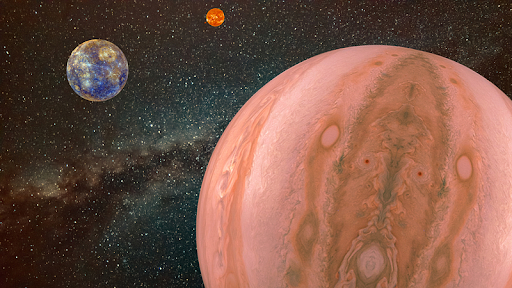In the quest to find alien life, scientists are searching for extrasolar Earth-Jupiter duos
"Of the other small planets like Earth that are out there, which of them have Jupiter siblings? Because this might be an important characteristic to look for, if we want to figure out where to find life."

Scientists have created a first-of-its-kind catalog of planets outside the solar system that exhibit similar sizes to Earth and are watched over by a "big sibling," Jupiter-like world. Known as the Kepler Giant Planet Search, the catalog took a decade to compile.
Finding extrasolar planets, or "exoplanets," in such configurations while orbiting a star, the team says, could be a critical component in our ongoing search to discover life elsewhere in the Milky Way. This is because Jupiter has been identified as a key component in allowing life to develop here on Earth.
The gas giant's gravitational influence in the early solar system, scientists believe, helped slingshot rocky and icy debris toward the young sun. These pieces served as building blocks that allowed primordial Earth to form. Moreover, some of this debris may have also carried the key components for life as we know it, such as water and foundational components of complex molecules.
"This catalog is the first of its kind and an unprecedented opportunity to explore the diversity of planetary systems that are out there with things that are like the solar system, but not exactly the solar system, and it gives us a chance to rewrite the story of how the planets form," Lauren Weiss, team leader and an assistant professor at The University of Notre Dame, said in a statement. "The science question that I’ve been trying to answer over the past decade is: Of the other small planets like Earth that are out there, which of them have Jupiter siblings? Because this might be an important characteristic to look for, if we want to figure out where to find life."
Related: NASA identifies 17 exoplanets with possible subsurface oceans
Watching 'wobbly stars' to spot far-out planets
Weiss and colleagues built the catalog by using data collected by the W. M. Keck Observatory located on Mauna Kea, Hawaii, to record the radial velocities — the speed at which an object moves away from Earth — of 63 sun-like stars that are known to collectively host 157 small planets.
These planets range in size from around the width of Mars, which is just a bit smaller in size than Earth, to about the diameter of Neptune — which is four times the size of our planet. Some of these worlds are thought to have solid rocky surfaces that could possibly support life we're familiar with. As they conducted their analysis, the researchers also spotted 13 Jupiter-like planets, eight roughly Neptune-sized worlds and three companion stars hanging around the main, target star subjects.
Breaking space news, the latest updates on rocket launches, skywatching events and more!
Despite their huge sizes, Jupiter-like planets can be difficult to spot when they are located far away from their stars or don't regularly cross, aka "transit," the face of their parent stellar bodies from our vantage point on Earth. Additionally, if these planets are tilted, the dips in starlight they cause as they make transits of their star are small and easy to miss.
The method the team used, the radial velocity technique, measures the change in light of a star that a planet causes as its gravity tugs on that star, causing it to ever-so-slightly "wobble" and move back and forth from Earth.
"Jupiters are large, and they pull a lot on the stars we can measure. We can find them if we take many, many measurements over time, which is exactly what I had to do," Weiss said.
For every star used by the team, Weiss and colleagues had to measure the shift in light for at least 10 nights — and sometimes for as long as several hundred nights while controlling the Keck telescope from remote observing stations. The length of time that a star was studied depended on the star, according to Weiss.
As well as making the discovery of Jupiter-like planets and delivering a catalog of Earth-like worlds with large sibling worlds, the research conducted by this team is the primary paper in the Kepler Giant Planet Search and will thus be the foundation of future research. Some of these future papers will focus on the orbital structure of distant planetary systems, while others will help refine planetary detection methods. Some will also collate partnerships of giant and small planets.
"Probably the thing I’m most excited about is revisiting this story of how the Earth formed," Weiss concluded. "Now that we have more information about what other kinds of planetary systems are out there, we’re looking for patterns, finding new discoveries, and these possibilities really excite me."
The team's research is set to be published in the Astrophysical Journal.

Robert Lea is a science journalist in the U.K. whose articles have been published in Physics World, New Scientist, Astronomy Magazine, All About Space, Newsweek and ZME Science. He also writes about science communication for Elsevier and the European Journal of Physics. Rob holds a bachelor of science degree in physics and astronomy from the U.K.’s Open University. Follow him on Twitter @sciencef1rst.
